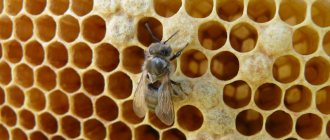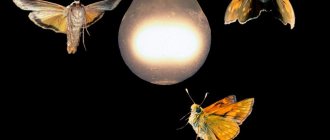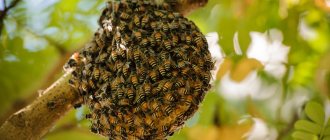Bort is the name given to a hollow in a tree if bees live in it. It forms naturally or is hollowed out by beekeepers. In order to secure the honeycombs, 2 snoses are placed in the side - poles that cross each other, and to collect honey they make dolzhei (narrow holes) and borteviki (long sticks with holes). Typically the size of the bead is one meter in length and 50 centimeters in width.
One tree can have up to three hollows, which does not harm it at all. The lowest edge should be at least four meters high to protect the bees from predators. In addition, it is believed that honey collected from high sides tastes better. The highest hollows were located at a height of 14 meters.
Bortis serve for 300 years. On average, 2 buckets of honey were obtained from one hollow, and with generous flowering of honey plants - up to 50 kilograms.
Origin story
The first beekeepers extracted honey from accidentally discovered hollows in which forest bees lived. Gradually, they learned to purposefully search for insect homes in order to obtain tasty and healthy prey.
In Ancient Rus', beekeeping became especially widespread in the 10th-17th centuries, occupying an important role among sectors of the economy.
At this time, the volumes of honey and wax were quite large. Gall, who traveled around Russia in the 11th century, noted in his notes the abundance of honey and wax. Beekeeping was especially developed in forest areas on the banks of the Oka and Desna, in the Dnieper region and near Voronezh.
The first beekeepers were, in a way, poachers. While collecting honey in the fall, they left the bee colony without food supplies, which led to the death of insects. Therefore, in the spring, beekeepers had to populate the hollows with new bee colonies, for which they often went to another area.
This method had several advantages. Thanks to the annual renewal of honeycombs, the rotting of the honeycombs was significantly slowed down, and the bees were rarely exposed to diseases and did not become smaller.
Decline of beekeeping
The first signs of the decline of beekeeping became noticeable in the 18th century. At this time, Tsar Peter brought vodka and wine to Russia, replacing the traditional mead. Wax was replaced by kerosene.
In addition, they began to cut down forests, freeing up land for arable land, which led to a reduction in the habitat of bees. To save their charges from destruction, beekeepers cut logs with hollows from fallen trees and transported them to another area.
The resulting structure was fixed to the tree, which turned out to be quite a labor-intensive task. To simplify the work, people found a clearing in which sparse cut trees grew (this is where the word “apiary” comes from) and installed the sides on the ground. As a result, insect monitoring and honey collection were facilitated.
In addition, the beekeepers began to leave part of the honey for their wards, which ensured the preservation of the bee colony in the winter. Thanks to such transformations, an apiary system emerged in the mid-19th century, which laid the foundation for modern beekeeping. At this time, log beekeeping replaced beekeeping.
Modern beekeeping
Nowadays, beekeeping and log beekeeping has been preserved in a single place - in the Shulgan-Tash nature reserve (previously called Burzyansky), located in Bashkiria.
It serves as a national symbol of the country, preserving its historical roots, promoting respect for nature, earnings and health. Each family has its own secrets that are passed on to their children.
The preservation of live beekeeping in Bashkortostan is explained by the fact that the local population did not build houses for a long time and led a nomadic lifestyle. Another prerequisite for the development of beekeeping is the presence of forests untouched by human hands. In addition, linden and maple trees, known as excellent honey plants, are common in the country.
The emergence of the fishery
Having understood the very concept of “beekeeping”, it is worth studying its history in more detail. As you know, humanity learned about the value of honey several thousand years ago. That is why in almost all ancient cultures this product and the insects that produced it were highly valued, and in Ancient India they were even deified.
Long before the beginning of our era, Egypt, Assyria, Greece, Rome and China managed to tame bees.
However, beekeeping was precisely a Slavic invention. This was facilitated by the presence of numerous forests. Among most eastern peoples, bee families settled in rock crevices. Although, in fairness, it is important to recognize that the inhabitants of the jungle also had a similar tradition - hanging logs with bee families near the trees.
As for beekeeping in Ancient Rus', it was during this period that it evolved from a simple hobby to a real industry. Previously, trees with bees in order to extract honey were simply set on fire, and the insects died. Gradually, the ancestors came to the conclusion that they could try to tame bee colonies rather than kill them.
Varieties
Depending on the types of forest dwellings for bees, several types of airborne beekeeping can be noted. But in order to subdivide them, you need to understand the principle of family formation.
Modern beekeeping involves imitation of old technologies, facilitated by modern tools.
At the very beginning of the development of such honey production, it was difficult to stop the random swarming of bees. This was due to the incomprehensibility of the structures of the dwellings of these forest honey plants.
The solution arose naturally when the deck began to be sawn. At the very top, beekeepers left a small hole through which it was convenient to collect honey. When observing the progress of swarming, it was decided to expand the honey plants’ homes, arranging them in large logs.
For the natural method, large hollows were selected, in which the honey production was more difficult than when collected in artificially created hives.
From the deck to the hives
Farming in logs was more profitable than simply collecting honey in the forests. However, beekeeping was clearly in need of technological progress. The technical revolution came only at the beginning of the 9th century.
It happened in Russia. In 1814, the Russian beekeeper Pyotr Prokopovich built and presented to the attention of his colleagues the so-called plank frame hive. This house was assembled and disassembled perfectly. Now, in order to get honey, there was no need to destroy the entire hive.
Not only Russian beekeepers liked Prokopovich’s idea. Soon the Russian hive began to be used and improved in other countries. For example, the American Lauren Langstroth made the bee house prefabricated and multi-body. The convenience of a modern hive is that if there is a large honey harvest, it can be built up using new frames. It is this improved version of Prokopovich’s invention that all beekeepers in the world use. The only exceptions to the rule are some African peoples who still breed bees in logs.
Further technical progress affected not the structure of the life of bees, but the process of pumping out honey. In 1865, a resident of Austria, Frantisek Grushka, invented a honey extractor, which helped pump out ripened honey using centrifugal forces.
Thus, through the efforts of people in many countries, honey production has become not only improved, but also automated.
Nuances of on-board beekeeping
The profession of beekeeper and its secrets, including magical spells, were passed down from generation to generation. Uninitiated people considered this profession dangerous and mysterious, and beekeepers were equated with werewolves and called squirrels.
In addition to being labor intensive, the profession also presented serious danger. It is known that the bite of one hundred medium bees (forest bees are much larger) can lead to death. And in one hollow there live over 20 thousand insects.
Therefore, in order to survive, people involved in beekeeping had to have certain knowledge about the behavior of bees and the necessary experience, as well as have good physical fitness, since they had to climb very tall trees.
To climb the tree, beekeepers used available means: lezivo (special ropes), kiram (special belt for fastening) or rope, claws, spikes, ladders. To protect themselves, they gradually improved their tools, among which a small ax with a crooked ax took center stage.
Horse hair was used to make protective masks, a ring-shaped knife, a hatchet, a chisel, a one-handed scraper and an adze were used to construct the sides, and a gun was used to protect against predators (they often returned from fishing with bear skin).
The beekeepers also had to protect the beards from bears who wanted to get a treat. For this purpose, a heavy log was tied near the entrance.
The bear, in order to penetrate the hollow, pushed away the log and received a retaliatory blow. He began to “fight” with the log to no avail until he retreated. To increase the effectiveness of protection, metal was hammered into the logs.
What should a good beekeeper be like?
In the modern world, almost anyone can become a beekeeper if they have a place to keep hives, some money and free time to do it all. This trade now does not require special skills and physical abilities, but in the old days it was not so.
Each beekeeper (that’s what those who raised bees were called) had to have good health, be strong, hardy and have a good understanding of plants.
As mentioned above, all types of sides were hung high above the ground, and in order to reach them, it was necessary to have dexterity and strength. After all, it was inconvenient to carry ladders with you, which meant that you had to climb trees with the help of a leather cord and devices similar in design to modern “claws” of electricians.
But on the farm of any self-respecting beekeeper, as a rule, there were dozens of bees, and each of them required attention and inspection. That is why ancient beekeepers were always famous for their strength and dexterity - there was no other way in this craft.
Another important characteristic of each specialist in this field was deep knowledge of botany. They were necessary to know where, and most importantly, when exactly to place the beads in order to obtain honey and wax of the best quality. That is why many beekeepers were also excellent herbalists. After all, they knew when plants and trees bloom and bear fruit, and how they affect the human body.
Over the centuries of beekeeping, the ancient Slavs developed several specialized tools that are still used today. In addition to a special hatchet, chisel, scrapers and knives for forming hollows of the desired shape and caring for them, already in the 10th century a protective mask woven from horsehair began to be widely used.
How to make a board with your own hands?
Do-it-yourself board scheme
What you will need:
- Inventory. An ax with a sharp blade and a chainsaw are required.
- Materials. You should take a wooden deck of a suitable size. The ideal materials are ash, linden and oak. You will need clay and a piece of iron.
Before you make a fence for bees with your own hands, you need to choose a living, healthy and fairly tall tree, the diameter of which should be at least 0.8 meters.
The best trees for borti are oaks and ash trees. A hollow is cut out of the tree and the inside is emptied. The length of the sides must be at least 0.9 meters, and the depth - up to 0.3 meters.
They also make a dovjeya (window) for inspection of the border and honey collection. The height of the dovjei corresponds to the height of the side, and the width varies between 12-18 centimeters.
After finishing the work, the window is closed with wooden lids, which are secured with maple wedges. The width of the lid is equal to the width of the dovzhei, and the height is about 6 centimeters. An important nuance is that the top cap should be longer than the bottom.
After making and closing the window, another hole is made - a taphole. It should be placed slightly above the middle of the side at a right angle to the main window.
Having a drawing, modern tools in addition to traditional ones and the necessary skills, you can make a bead with your own hands in one day. But it is not enough just to make it; it is necessary to ensure its safety for many years.
Thus, in winter, increased humidity forms in the hollow, which leads to rotting of the wood and a decrease in the productivity of the bee colony. To prevent such problems, it is recommended to create a ventilation system in the form of microscopic holes.
You should also clean the honeycombs in a timely manner. Their accumulation in a hollow can cause the death of insects.
Advantages and disadvantages
There are several advantages of airborne beekeeping over conventional beekeeping:
- Health of the bee colony. For the winter, bees are left in the nest with a supply of honey, which has a positive effect on the immune system. The bees in the hives are usually given sugar syrup.
- Manufacturing of honeycombs. The bees themselves determine the size of the honeycombs in the hive. They usually make them larger, which has a positive effect on insects that grow larger.
- Number of bees. The sides accommodate 3 times more bees than the hive. Usually up to 20 thousand. Accordingly, they produce more honey and are less susceptible to swarming.
- Productivity. From 1 bean you can get about 2 buckets of honey, and if the honey plants are in good flowering - up to 50 kg.
- Saving. Requires less time and cost to care for bees.
But you should also pay attention to the disadvantages:
- The capriciousness of bees. If the insects do not like the material from which the fence is made, they may refuse to settle. Therefore, you need to approach the choice of wood especially responsibly.
- Probability of bees dying. During honey collection, when honeycombs are cut out and broken out, insects can be harmed.
- Independence of the bee colony. The beekeeper has virtually no control over them.
- The importance of skills. The craft requires good knowledge of beekeeping and proper training.
Collecting wild honey from the Slavs
Add to favorites
Today, wild bee honey is exotic for us, although historically, not so long ago in Rus', this product was the only sweet that people had at their disposal. And they knew how to extract large quantities of this wonderful product in difficult wild conditions, trying, at the same time, not only not to destroy bee colonies, but also to help them settle into new homes. Read more about collecting honey from wild bees in Rus' further in the article.
Features of on-board honey
The honey obtained from forest bees is unique. It is distinguished by its increased purity and great value, due to which it is widely used in alternative medicine.
It is rich in vitamins and mineral elements, which provides its nutritional value, helps strengthen the body's defenses and get rid of many diseases. Its use is especially recommended for colds, sore throat, flu, acute respiratory viral infections, and pneumonia.
Borbor honey is characterized by a dark brown color, tart taste, smoked linden aroma and excellent digestibility. It is opaque, very thick and very viscous. It is assembled by hand, without the use of mechanics.
Honey does not undergo pumping, which allows you to save all the beneficial substances and enzymes.
But in order for it to retain its properties in the future, it must be stored in containers made of natural material, for example, in clay pots or cedar barrels.
Side dark forest bee
The dark forest bee Apis mellifera mellifera is a unique subspecies of the honey bee Apis mellifera, evolutionarily adapted to life in the continental climate of Northern Eurasia with long, cold winters.
At the present stage of development of beekeeping, bees of this subspecies have survived only in a few isolates in the form of small islands in Eurasia.
The most numerous tracts of dark forest bees in Eurasia are found in Russia: about 300,000 families weakly affected by spontaneous hybridization in the Republic of Bashkortostan in the Southern Urals, about 200,000 families in the Perm region in the Middle Urals [(Ilyasov et al., 2006) and about 250,000 families in the Republic of Tatarstan in the Volga region.
There is information about the conservation of significant areas of the dark forest bee in the Republic of Udmurtia, the Kirov region and the Altai Territory (Ilyasov et al. // Beekeeping—2007, Brandorf et al., 2012).
Approximately 99% of dark forest bee families in the Southern Urals are kept in frame hives and about 1% live in forests in natural and artificial (boards and logs) hollows in tree trunks, mainly in the Burzyansky region of the Republic of Bashkortostan.
The evolution of the dark forest bee here took place together with the heart-shaped linden Tilia cordata, so their main unique honey collection is formed during the flowering of the linden.
Biosphere
Burzyan bees
Currently, dark forest bees, living in the sides, logs and natural hollows, have been preserved in the Southern Urals in the Shulgan-Tash state reserve with an area of 22 thousand hectares (created in 1958), the regional natural reserve "Altyn Solok" with an area 90 thousand hectares (established in 1997) and the Bashkiria National Park with an area of 82 thousand hectares (established in 1986).
At the end of 2014, during the period of another population depression, on the territory of the reserve, wildlife sanctuary and national park there were more than 1,200 trees with sides and logs, of which about 300 artificial hollows were populated.
Approximately 4 thousand bee families of the Burzyan population in this zone are kept in apiaries with frame hives, and in natural hollows, according to extrapolation of accounting materials, 200-400 “wild ones” live.
In 2012, the listed specially protected natural areas, along with a number of others, received the status of the UNESCO complex biosphere reserve “Bashkir Ural” with a total area of 346 thousand hectares, and the regional reserve “Altyn Solok” began to be actually protected by the Ministry of Natural Resources and Ecology of the Republic of Bashkortostan.
Currently, in order to preserve the Burzyan bee and as part of the development of the reserve, it is planned to expand the territory of the Shulgan-Tash reserve in the north-west direction due to the undeveloped territory in the interfluve of the Nugush and Uryuk rivers.
Employees of the Shulgan-Tash Nature Reserve, the Altyn Solok Nature Reserve and the Bashkiria National Park, together with local beekeepers, constantly carry out measures to optimize the number and selection work to increase the immunity, winter hardiness and productivity of Burzyan airborne bee families, and disseminate the experience of airborne beekeeping.
This policy of state environmental institutions makes it possible to preserve a unique population of bees - an isolate of A. m. mellifera in Eurasia under new threats of spontaneous hybridization and habitat destruction.
Honey and beekeeping in people's lives
Flower nectar processed by bees was of great importance for the inhabitants of Rus'. The significance of this or that phenomenon in people’s lives can always be judged by holidays.
Until pagan holidays were supplanted by significant dates with the names of Christian saints, the following honey holidays were celebrated in Rus':
- The beginning of the spring honey harvest. In different regions, the hives were taken out into the fresh air at different periods, but on average, the day of spring honey collection was celebrated on April 30, that is, “on Zosima.”
- Honey Spas. This is the time when the main honey harvest has already been harvested. In Christian times, on this day honey was taken to church for the ritual of illuminating fresh honey, as well as honey products. Previously, this holiday fell on August 1, but now it is celebrated on August 14.
- The third honey holiday is intended to close the circle of the annual cycle. On this day, the hives are removed for the winter.
Nowadays, all these holidays have lost their relevance, which cannot be said about the sweetest product. It remains popular, in demand and profitable.











